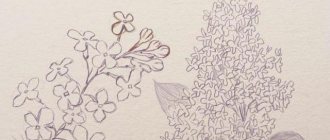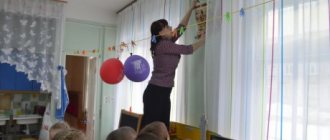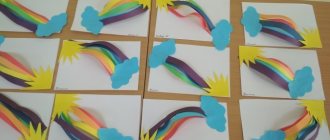Competition presentation “Colors of the Rainbow”
Lesson notes for the presentation “Colors of the Rainbow” on visual arts for preschoolers in the system of additional education for children. The topic of the lesson is Colors of the Rainbow. Objectives: • To give an idea of primary colors. Introduce children to the natural phenomenon of rainbows. • Show ways of mixing primary colors to create new ones using the example of a rainbow. • Develop creative and artistic abilities. Objectives: • educational - introduce primary and composite colors, learn to mix primary colors to obtain composite colors. • developing - develop the ability to work with paints, use a palette to obtain new colors. • educational - to cultivate an aesthetic perception of nature. Materials and equipment: gouache (blue, yellow, red), brushes, palettes, sheets of paper with a rainbow for coloring, paintings with a rainbow, presentation. Progress of the lesson 1. Organizational moment. 2. Activation of cognitive activity. A colored rocker hung over the river. What is this?... (rainbow). When can we see a rainbow? Slide 2. Spring sun and rain Together they build a rainbow - A seven-color semicircle of seven wide arcs. The sun and the rain don't have a single nail, And they built the Celestial Gate in no time. 3. Presentation of new material. Slide 3. Often after rain, when the sun is shining, a rainbow appears in the sky. Along it we can get to visit the sun, like on a bridge. The rainbow consists of seven multi-colored arcs. While our rainbow is still white. To make it colorful, paints will help us. Slide 4. Let's color the arcs of the rainbow using only three colors: red, yellow, blue. These are the primary colors. By mixing them you can get new ones. Three colors, three colors, three colors, Guys, is this a lot? Where can we get green and orange? What if we mix paints in pairs? In order to get new colors, a palette will help us. Here we will experiment with paints and see what comes out of it. We will mix paints in pairs. 4. Practical work. 4.1. Safety precautions when working with paints. 4.2. We draw a rainbow by consistently analyzing colors and experimenting with paints to obtain new colors. Let's begin! 1) The first arc of the rainbow is red. • What could be the color red? (children's answers) Slide 5 Red radishes grew in the garden bed, Nearby there are tomatoes - red kids. Red is the main color. 2) After the red one there is an orange arc. • What can be orange? (children's answers) Slide 6 The orange fox dreams of carrots all night - It looks like a fox's tail: Orange too. Side 7 Orange is a composite color. It can be obtained by mixing yellow and red paints. (Children get the color orange by experimenting with paints.) Red plus yellow, It’s no secret to everyone, They will give us, of course... ORANGE color. 3) The next arc is yellow. • What can be yellow? (children's answers) Slide 8 The yellow sun looks at the earth, the yellow sunflower watches the sun. Yellow pears hang on the branches. Yellow leaves are flying from the trees. 4) After the yellow one there is a green arc. • What is green? (children's answers) Slide 9 We grow green onions and green cucumbers, and outside the window there is a green meadow and whitewashed houses. Children get the color green by experimenting with paints. Slide 10 We mix blue and yellow GREEN color and we get... Green is a composite color. 5) After the green one there is a blue arc. • What could be blue? (children's answers) Slide 11 My doll has blue eyes, And the sky above us is still bluer. It is blue, like a thousand eyes. We look at the sky, and the sky looks at us. Slide 12 How to get blue? • If you add white paint to blue paint, you get a blue color; white paint makes the colors lighter and more delicate. 6) The next arc is blue. • What is blue? (children's answers). Slide 13 There is an island in the blue sea. The path to the island is long. And on it grows a flower - Blue-blue cornflower. Blue is the main color. 7) The last arc is purple. • What could be purple? (children's answers). slide 14 The purple violet is tired of living in the forest. I'll pick it and bring it to my mom on her birthday. She will live with purple lilacs. On the table in a beautiful vase near the window. Slide 15 From blue and red - this is the color we get... PURPLE. Purple is a composite color. So a rainbow flashed in our sky. Slide 16 The colors were very tired today: They painted a rainbow in the sky. We worked for a long time on the rainbow of colors. The rainbow came out beautiful, like in a fairy tale. All colorful - what a beauty! Just admire the colors. Slide 17 We will name seven flowers, We will cross the bridge. 5. Securing the material • Do you think these colors always appear in a certain order? (children's answers). Children: Red, orange, yellow, green, blue, blue, purple. • To remember the sequence of colors of the rainbow, people came up with a tongue twister: Slide 18 “Every hunter wants to know where the pheasant sits.” 6. Reflection (summarizing the lesson). Analysis of received works. The sun gives a smile - a good mood.Summary of GCD for children of the preparatory group with a presentation on the topic: Rainbow
Summary of direct educational cognitive and research activities of children of the preparatory group on the topic “Rainbow”
Program content: • To acquaint children with the atmospheric phenomenon of the rainbow, to reveal the reason for its appearance (reflection, refraction and decomposition of sunlight). • Learn to understand and explain the meaning of the figurative expression “rainbow mood”. • Fix the colors of the spectrum and their sequence. • Develop curiosity, memory. • Create a desire to participate in experimental activities. Preliminary work: • experimental activity on the topic “refraction and reflection of light”, “Colors of the spectrum, their sequence” • Vocabulary work: refraction, reflection, spectrum.
Progress of organized educational cognitive and research activities of children:
A cell phone rings in the group.
— Guys, we received an audio message. Let's listen. Hello guys! My name is Katya, I'm only 4 years old. I was told that in the Khrustalik kindergarten there are smart and sympathetic children, kind and resourceful teachers. Can I contact you with a request? Please tell us what “Rainbow” is, where it comes from and why. Ask the teachers to make a video letter for me and send it to…. - Who saw the rainbow? When it was? In dry, hot weather, during or after rain? Usually we see a rainbow when the rain has not stopped yet, but the sun is shining in the sky. To see a rainbow, you need to stand with your back to the sun. - Shall we help Katya? Where shall we begin? First, let's answer the question: “What is a rainbow?” children's answers. “Once upon a time, a person began to wonder why rainbows appear in the sky. People in those days could not explain this phenomenon, so they came up with myths and legends. Some superstitious people thought that this was a bridge to the other world, but scientists have found an answer to this phenomenon. So, a rainbow is a natural phenomenon that occurs when it rains and the sun shines. The teacher invites the children to look at several pictures of a rainbow: - The artist painted several rainbows. Guess which picture shows the rainbow that he saw after the rain (not a fairy-tale rainbow, but a natural phenomenon). View the presentation (1,2,). How is it different from your pictures? (sequence of colors). How many colors does the rainbow have? The rainbow consists of seven colors, and they all follow strictly one after another, each “knows its place.” True, in nature there are no clear boundaries between colors; they smoothly transform into each other. There is an expression that helps to remember the arrangement of colors in the rainbow: Every Hunter Wants to Know Where the Pheasant Sits (the first letter of each word indicates a specific color: red, orange, yellow, green, blue, indigo, violet). - Now go to the table and lay out all the colors of the rainbow in order, from top to bottom (complete the task). — What color is green? Blue? 1st what color? 6th? — View the presentation (3). -Why does a rainbow appear? Do you want to know? -Name the properties of water. (+refracts light, reflects rays of light) -Let's remember what color is sunlight? (Consists of 7 colors of the spectrum) - Why do we see the sun's rays as white or yellow? (experience with a spinning top and a spectral circle) - What happens to a sunbeam if it hits water? (refracted). Who can demonstrate an experiment with the refraction of light? Do you have any idea how a rainbow appears? - I suggest you conduct an experiment. Fill the bath with water and place it on the table. Dip the mirror halfway into the water. Its upper part will rest on the edge of the bath, and the lower part will be in the water at an angle. Let's direct the flashlight light to the part of the mirror immersed in water. In this case, the mirror will reflect the light. Take a piece of paper and place it in front of the mirror. With your other hand, move the mirror itself slightly. Change the position of the mirror and paper until a multi-colored rainbow appears on it. Rock the bath gently to make ripples in the water and shake the mirror. What do we see now? -sparkling multi-colored lights appear on white paper. This means that an ordinary ray of sunlight, like a magician, can turn into a multi-colored one if it passes through drops of water. - Now I suggest you experiment and get a rainbow yourself (children's experimentation). Physical exercise: Look: a rainbow above us, Above the trees Draw a semicircle with your hand above your head
(swing movement).
Raise your hands up, fingers open.
Houses
Hands folded over the head with a roof.
And over the sea, over the wave
Draw a wave with your hand.
And a little bit above me.
Touch your head. They go to the chairs.
- Why do you think the rainbow appeared? — The sun's rays, falling on raindrops in the sky, are refracted, reflected and disintegrate into multi-colored rays. This is how a rainbow is formed. View the presentation (4). — At what time of year does a rainbow occur? (children's answer). Presentation (5,6,7,) -Rainbows most often appear in summer, can be seen in spring and autumn. And the most amazing thing, in my opinion, is a rainbow in winter! This is very strange, unusual. The frost is crackling, the cold winter sun is shining in the pale blue sky, and tiny ice crystals are floating in the air. A ray of sun passes through these crystals, is refracted and reflected in the sky as a beautiful rainbow. Some Muscovites were lucky enough to see such a rare picture several years ago, in the depths of winter. Presentation (8,9) - Usually a ray of sunshine and raindrops build one rainbow at a time, and not often. But it happens that, to everyone’s joy and surprise, two rainbows immediately appear in the sky. One of them is brighter, the other is paler! Even more rarely, as many as four or five rainbows shine in the sky at once - this only happens over large rivers and lakes. But that’s not all the miracles. Sometimes a rainbow can be seen at night, when the moon peeks out from behind the clouds after rain. In its dim rays a lunar rainbow is also born, of course, not as bright as the solar one. Presentation (10) - Do you think it is possible to see a rainbow from an airplane? Scientists managed to photograph a rainbow from an airplane. This is what it looks like from above. -What does the word “rainbow” mean? What word does it look like? The word "rainbow" is similar to the word "joy". It’s joyful when suddenly a surprisingly beautiful arc appears in the sky. In the old days they called it “Paradise Arc” and believed that it brings happiness. Since then that’s what they call it – rainbow. Seeing a rainbow is a very good omen, foretelling happiness. It is generally accepted that if you find the place where a rainbow originates, you can find a treasure there. — There is such an expression as “rainbow mood.” What do you think it means? -Yes, a rosy mood—cheerful, full of hope. Reflection: -When does a rainbow appear? - So, why does a rainbow appear? - Why is the rainbow multi-colored? - How many colors are there in it? -For whom today’s lesson was not in vain? — Who learned something new in this lesson? - If you were interested in the lesson, you were satisfied with yourself, give me a smile. - Thank you for your work, and we will send Katya a disk about the rainbow at the address...
Presentation on the topic: Rainbow
We recommend watching:
Summary of educational activities on multitherapy for the preparatory group. Summary of a lesson on speech development in the preparatory group with presentation. Retelling of the story by Sukhoml Lesson for older preschoolers on the world around them on the topic “Pets” with a presentation Integrated OD in the preparatory group with a presentation on the topic: “The Five Senses”
Similar articles:
Abstract of GCD in mathematics in the preparatory group. Counting to 11 and 12
Summary of mathematics lessons in the preparatory group. Number composition
Summary of mathematics lessons in the preparatory group. Adding and subtracting numbers
Abstract of GCD in mathematics in the preparatory group. Count to 15
Lesson notes for the preparatory group. Age line
Presentation on the world around us for preschoolers “Seven Colors of the Rainbow”
40 slide
The presentation “Seven Colors of the Rainbow” introduces young children to the seven colors of the rainbow and serves to improve reading skills according to G. Doman’s method (according to the method, the text comes first, then the picture). The presentation uses a poem by Anya Aksyonova (fifth place in the competition “Poems for Children-4” of the Great Wanderer for the Young Foundation https://www.stihi.ru/poems/2007/03/23-2184.html). The beginning and end of the poem had to be slightly altered. The presentation contains a game test in which the child must choose a bubble with the name of the desired color. On slides with a choice of an answer, each option can be spoken out several times: first when formulating a question, then when you hover the mouse over the bubble with the answer, the answer option is spoken out, and the bubble is highlighted in a contrasting color. Clicking the mouse on the cloud gives the result: that's right - it's... color or think about it. If you only need to run a game test, then the link to it is on the first slide. The program is designed for children from one to three years old. For children under two years old, I recommend showing only the poem without a play test. Each test slide has an exit button in the lower right corner. If the child does not yet know how to use a mouse, then in this case his mother will come to his aid. The program, to some extent, can also serve as training in mouse handling skills. PS On slide 20, “owners” of daughters can slightly correct the text: change “son” to “daughter”. If the child's name “rhymes”, it is better to insert the name. Author: Olga Stupen E-mail The presentation “Seven Colors of the Rainbow” introduces young children to the seven colors of the rainbow and serves to improve reading skills according to G. Doman’s method (according to the method, the text comes first, then the picture). The presentation uses a poem by Anya Aksyonova (fifth place in the competition “Poems for Children-4” of the Great Wanderer for the Young Foundation https://www.stihi.ru/poems/2007/03/23-2184.html). The beginning and end of the poem had to be slightly altered. The presentation contains a game test in which the child must choose a bubble with the name of the desired color. On slides with a choice of an answer, each option can be spoken out several times: first when formulating a question, then when you hover the mouse over the bubble with the answer, the answer option is spoken out, and the bubble is highlighted in a contrasting color. Clicking the mouse on the cloud gives the result: that's right - it's... color or think about it. If you only need to run a game test, then the link to it is on the first slide. The program is designed for children from one to three years old. For children under two years old, I recommend showing only the poem without a play test. Each test slide has an exit button in the lower right corner. If the child does not yet know how to use a mouse, then in this case his mother will come to his aid. The program, to some extent, can also serve as training in mouse handling skills. PS On slide 20, “owners” of daughters can slightly correct the text: change “son” to “daughter”. If the child's name “rhymes”, it is better to insert the name. Author: Natalya Novolodskaya E-mail




